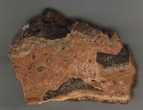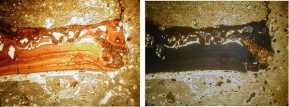A comprehensive article on the Azuara shock effects with emphasis on the F. Langenhorst and A. Deutsch quarrel may be clicked HERE.
Highly shocked polymictic dike breccia (near Santa Cruz de Nogueras, 30660971E, 4553223N). Typical shock effects in the breccia are |
||||
 A A
|
||||
 BB: Diaplectic glass; photomicrograph of a sandstone fragment completely transformed to diaplectic quartz; plane polarized light and xx nicols. Note that there are a few holes in the thin section not to be confused with diaplectic quartz grains. The field is 600 µm wide. BB: Diaplectic glass; photomicrograph of a sandstone fragment completely transformed to diaplectic quartz; plane polarized light and xx nicols. Note that there are a few holes in the thin section not to be confused with diaplectic quartz grains. The field is 600 µm wide. CC: Planar deformation features (PDFs) in quartz grains; sandstone fragment from the shocked breccia. Photomicrograph, plane polarized light; the field is 800 µm wide. Note the large number of grains showing PDFs, their high density, the small spacing and the multiple sets. Up to five sets of different PDF orientation per grain have been observed in the dike breccia. CC: Planar deformation features (PDFs) in quartz grains; sandstone fragment from the shocked breccia. Photomicrograph, plane polarized light; the field is 800 µm wide. Note the large number of grains showing PDFs, their high density, the small spacing and the multiple sets. Up to five sets of different PDF orientation per grain have been observed in the dike breccia. DD: Planar fractures (PFs; cleavage) in quartz. Photomicrograph, xx nicols; the field is 450 µm wide. Note that at least six sets of different orientation can be observed. Cleavage in quartz is very uncommon in tectonically deformed quartz. In rare cases, rhombohedral fracturing is observed to occur in rocks which underwent strong regional metamorphism. In rocks from impact structures, PFs in quartz belong to the regular shock inventory. DD: Planar fractures (PFs; cleavage) in quartz. Photomicrograph, xx nicols; the field is 450 µm wide. Note that at least six sets of different orientation can be observed. Cleavage in quartz is very uncommon in tectonically deformed quartz. In rare cases, rhombohedral fracturing is observed to occur in rocks which underwent strong regional metamorphism. In rocks from impact structures, PFs in quartz belong to the regular shock inventory.  E E
E: Kink bands in biotite from the shocked polymictic breccia. Photomicrograph, crossed nicols; the field is 840 µm wide. – Although kink bands can form under static conditions of strong regional metamorphism, the high frequency of the kink bands shown here, their narrow width, and their high kink-angle asymmetry point to shock deformation. The shock-metamorphic effects shown here correspond to a broad range of shock pressures. The melt glass, however, shows that parts of the breccia must have experienced shock peak pressures exceeding 500 kbars (50 GPa).
|
|
|||






































































